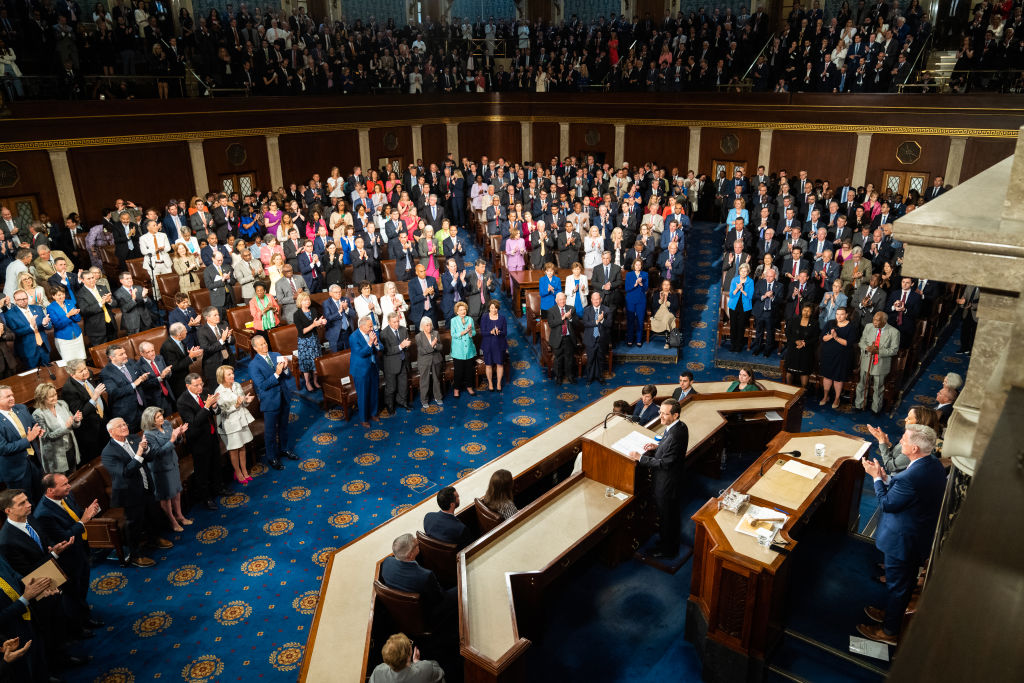Being a defender of the U.S. Congress isn’t always easy. When I tell people that I study the first branch of government for a living, their response is often, “I’m sorry.” As Rep. Derek Kilmer—himself a vigorous advocate for a healthy legislative branch—once noted: Congress is less popular than “head lice and Nickelback.”
Yes, the House and Senate don’t always make it easy to advocate on behalf of the institution, and not only because of objectionable individual behavior or their difficulty completing fundamental responsibilities of governing. It’s also because when the White House is occupied by a co-partisan president, members of Congress themselves increasingly call for executive action.
It’s a bipartisan activity. “I don’t want anyone to think that we believe executive action is better than legislation,” argued Rep. Pramila Jayapal, chair of the Congressional Progressive Caucus, in 2022. But she added, “Certainly there are a lot of areas where a) if we don't get legislation, the administration can take action, and b) the administration can take action to help move us more quickly towards the goals that we're working on.” Similarly in 2019, Rep. Mark Meadows, who at the time chaired the House Freedom Caucus and lamented the amount of funding a spending measure allocated for a barrier on the southern border, tweeted that “At this point it’s clear: POTUS should take executive action.”
It's not hard to understand why members make these appeals to the executive branch. Divisions between the parties are high, and divisions within them, though smaller, are also consequential. Majorities are frequently narrow, and the policy problems facing the country are significant. These challenges make it harder for some to see why we should value Congress as an institution.
Philip Wallach’s new book, Why Congress, makes a case to the contrary, offering a full-throated defense of the institution. In doing so, Wallach argues that it is not just how policy problems get solved that matters, but by whom and in what way. Congress—yes, that less-popular-than-Nickelback Congress—is the right venue for doing so.
As Wallach aptly notes, “Political work is not just policy engineering.” The “just” here is important; policy design is certainly one of Congress’ responsibilities. But it is not its only job. Congress is also a place where members from every corner of the nation come together to represent the interests of their constituents and, ideally, build coalitions, engender trust, and convince voters they have completed their work to the best of their abilities. “An assemblage of representatives drawn from the whole of our diverse, factious country,” Wallach writes, “can forge a sense of national identity in a way the acts of a singular head of state or of a centralized bureaucracy cannot.”
To what ends should this “assemblage of representatives” be directed? For Wallach, there is value in a process of deep deliberation, negotiation, and compromise, because engaging in such work demonstrates that whatever the outcome is, it was the best possible one available in the face of the country’s “manyness.” This “mutual seeking of workable compromise,” as he describes it, “generates policies that don’t conform to any side’s ‘right answer.’”
In the legislative process, Wallach argues, it is vital that the losers feel like they have been listened to, and the public is more likely to view outcomes that result from such a process as legitimate. The Congress that meets Wallach’s expectations acts on hard problems, and incorporates more voices within the chamber in the process.
Wallach uses the Civil Rights Act of 1964 as an example of how vigorous deliberation can increase the perceived legitimacy of an outcome. Senate Majority Leader Mike Mansfield, he argues, structured the bill’s deliberation with an eye toward ensuring that all perspectives, even the racist ones against the bill, were well-represented.
Mansfield, for example:
shunned [President Lyndon] Johnson’s preferred strategy of round-the-clock sessions meant to exhaust the Southerners. “This is not a circus sideshow,” he said. “We are not operating a pit with spectators coming into galleries at night to see senators of the Republic come out in bedroom slippers without neckties, with their hair uncombed, and pajama tops sticking out of their necks.
Mansfield consulted with the leader of the opposition to the measure, Sen. Richard Russell, to devise a procedural strategy that would simultaneously avert some of the greatest potential hurdles for the bill (it would not, for example, be referred to the Senate Judiciary Committee) and drive toward a favorable resolution, while also treating the “team of Southern intransigents with the utmost comity and respect.”
Readers (including this one) may disagree with Wallach on the degree to which “Southerners accepted Congress’ act as a legitimate manifestation of the rule of law” in the years following its passage. But if we accept that legislators on the losing side want to be able to demonstrate that they went down fighting, Wallach’s account certainly suggests Southerners could credibly claim they did.
Could today’s members be motivated to accept outcomes with which they disagree if first given the opportunity to vigorously air their opposition? Or could legislators believe that performative grandstanding, the “circus sideshow” to which Mansfield objected, is instead what their constituents demand?
Earlier this year, House Speaker Kevin McCarthy reportedly promised Republican opponents within his conferences that, in exchange for supporting his speakership bid, members would get more opportunities to offer amendments on the House floor. When the annual bill setting policy for the Department of Defense came up for debate last month, amendments included a range of divisive social issues like abortion; gender-transition treatment for transgender troops; and diversity, equity, and inclusion training. Unsurprisingly, the amendments reduced support on the final vote from Democratic members, even on a measure that had advanced out of the House Armed Services Committee on a 58-1 vote just a few weeks earlier.
Where is the line between performative conflict and the compromise-producing conflict that Wallach advocates? On which side does behavior like the one seen in the defense authorization bill fall? Some sponsors of these “hot button” amendments would certainly argue that they are, in fact, representing their constituents’ sincerely held beliefs.
Political science research, meanwhile, provides a mixed picture of whether voters actually desire the “circus sideshow” that Mansfield bemoaned. On one hand, being told that a new law was passed using “unorthodox procedures” makes people less likely to approve of the action—especially among individuals who, for partisan reasons, were already primed to oppose the new legislation. Other work suggests that telling survey respondents that the majority party ignored alternatives lowers support for the final policy outcome.
Despite this interest in “procedural fairness,” there’s also evidence that at least some voters value performative politics. Voters who strongly identify with one of the two political parties, while favoring compromise in the aggregate, tend to support individual members of Congress engaging in partisan conflict. (It’s worth noting that this dynamic is not unique to the U.S. Literal brawls in the Taiwanese legislature persist—despite general disapproval—because of the signals they send to strong party supporters.)
The examples Wallach offers for “when Congress worked,” including his discussion of civil rights, certainly weren’t immune from the tension between performative and compromise-driving conflict. But the high levels of partisanship today present new challenges in how to navigate them.
In their 2020 book The Limits of Party, James Curry and Frances Lee conclude that “highly partisan eras like today’s may instead just serve to inflate public expectations and end in even more disappointment with the parties and with Congress.” This may be the central challenge to avoiding the worst, institutionally speaking, of the “three futures for Congress” that Wallach offers in the conclusion to his book, in which Congress descends into “decrepitude” or cedes even more power to the executive. Parties make promises, but then fail to satisfy them—not only because of multiple veto points in the American system, but also because of the diversity of interests within parties themselves. When voters, particularly strong partisans, respond by calling for legislators from their parties to simply “fight harder,” a vicious cycle of performance and disappointment results. Wallach is right in imploring that we shouldn’t give up on Congress—but the code to usher in a “revival” is one we’ve yet to crack.





Please note that we at The Dispatch hold ourselves, our work, and our commenters to a higher standard than other places on the internet. We welcome comments that foster genuine debate or discussion—including comments critical of us or our work—but responses that include ad hominem attacks on fellow Dispatch members or are intended to stoke fear and anger may be moderated.
With your membership, you only have the ability to comment on The Morning Dispatch articles. Consider upgrading to join the conversation everywhere.